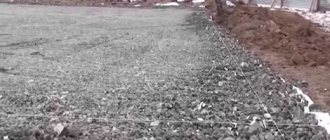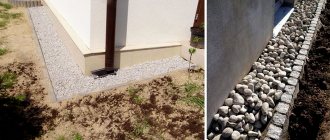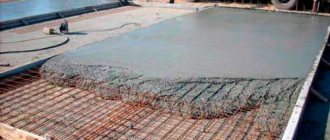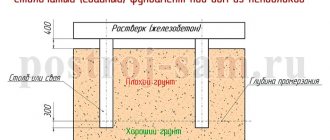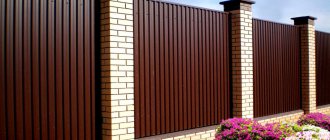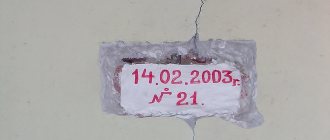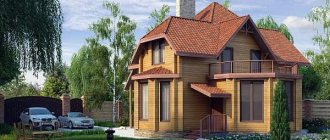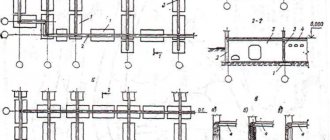If you want to sleep peacefully, choose the right pillow. Especially if you are going to sleep in your house, and the pillow is the underlying layer under its foundation. Let’s say right away: for a serious building, a cottage of any number of floors, the pillow should be made of crushed stone. You can spread sand under a shed or a light panel house. A massive structure requires a more solid foundation.
The soil can serve as a cushion only if, when digging a pit, you reach a natural crushed stone layer of the required thickness. In other cases, it must be organized independently.
A crushed stone cushion has higher strength than sand and is used for massive structures
Options for crushed stone fractions and the main purposes of its use in solution
Various types of crushed stone fractions are used for concrete under the foundation. The size of the material affects the strength characteristics of the building and more. More about this:
- For medium-sized future buildings, fine crushed stone is used, which can be used independently;
- Large crushed stone is used only for laying large buildings. Most often these can be multi-story structures.
Crushed stone of medium-fraction characteristics is used for massive structures. It will definitely need to be mixed with fine material;
When using fine crushed stone, you should be careful and vigilant. When the diameter of the grains is less than five millimeters, the material can no longer be considered crushed stone; it is rather sand, the use of which significantly reduces the strength characteristics.
Types of foundation substrates using crushed stone
Sand-crushed stone cushion having sufficient strength to support a building of several floors. The most common application is the construction of large private residential buildings and cottages.
The sand-crushed stone cushion is a two-layer structure - the bottom layer consists of sand, and the top layer consists of crushed stone. It is their combination that makes it possible to increase the permissible load and increase the weight and dimensions of the building.
Two layers of materials act as a consistent mediator of pressure from the building to the ground. Crushed stone is not as prone to crushing and leaving the base as sand, so it bears the main load.
The sand under the crushed stone has a larger area of contact with the gravity of the house, and is therefore less susceptible to its effects. Better distributed load increases the strength properties of the cushion when compared with the sometimes used single sand layer. The standard thickness of the substrate is 30-35 cm, of which 20-25 cm is crushed stone.
Concrete pad. Despite the name, the concrete layer is not laid directly on the ground, otherwise numerous subsidences will significantly reduce its strength. Under the cast concrete slab there must be a backfill of crushed stone.
The thickness of the crushed stone backfill is typically 10-15 cm, and the thickness of the concrete pad layer is 25-30 cm. The concrete base should protrude 15 cm beyond the boundaries of the future foundation in order to achieve maximum stability of the house.
In the video, a trench under the foundation has already been filled with crushed stone:
Forming a cushion from crushed stone
The installation of a pillow under the foundation is carried out in several stages.
- Laying a sand layer. We still can’t do without sand - it will separate the crushed stone backfill from the soil. The thickness of the sand layer at the bottom of the pit should be 10–15 cm. For these purposes, use high-quality medium or fine river sand without organic inclusions.
It must be well leveled, moistened and compacted. If the sand is already moistened, there is no need to compact it.
Before laying crushed stone, the sand layer must be moistened and compacted
- Forming a cushion from crushed stone. Its layer must be at least 25 cm thick. The crushed stone must be leveled and compacted well with a special roller. The pillow should protrude beyond the foundation by 20 cm in each direction.
- Foundation device. It is produced using a special cement mortar, which is laid on top of crushed stone in a layer of 20 cm.
When forming a cushion, pay attention to the level of groundwater rise; if it is very high, it is better to increase the thickness of the layers. When laying them, make sure the surface is even and horizontal - this is an important point.
The type, thickness and other dimensions of the cushion largely depend on the type of foundation it will support. By the way, in order to completely prevent the soil from mixing with the first sand layer, the bottom can be paved with a waterproof material, for example, the same roofing felt.
The pillow should extend beyond the edges of the foundation by 20 centimeters
Preparing the soil for the foundation - general rules
Numerous types of soil, as well as various weather conditions, influence the composition and technology of laying the foundation. For accurate calculations in construction, a number of rules, formulas and reference values are used to determine the required parameters of the materials and work used. In addition, when constructing buildings, they are guided by GOST standards for building crushed stone.
- The foundation is never installed on black soil. Even during the construction of non-critical buildings (shower stall, toilet or storage room for equipment), a foundation located on top of black soil will cause a dangerous distortion of the entire structure in a few years. The fertile and unstable layer of soil is small in thickness - up to 30-50 cm. Removing it manually is not difficult, but it will reliably protect you from negative consequences. The surface of the foundation pit or trench must be horizontal. The reason lies not only in the excess consumption of materials when leveling the slope, but also in the strength gradient of the resulting substrate. In its thinnest place, defects are most likely to occur. To prevent the transition of sand from the bottom of the substrate into clay, it is desirable to use geotextile materials. The time interval between excavation and laying of the foundation should not be prolonged. Otherwise, the work will be hindered by the soil, which constantly rolls into a pit or trench when it dries. The compaction of the cushion under the foundation should be done using a special vibrating plate, also called a “vibrating heel”. After compaction, you can walk on the crushed stone bed without disturbing the surface.
Purpose of pillows under the foundation and their types
To summarize the purpose of a foundation pillow, we will highlight several main functions that it performs.
- levels the platform on which the base of the entire structure is installed. The foundation will be made at the same height, which will eliminate uneven construction of structural elements;
- uniform distribution of the load on the soil from the finished structure. Increasing the service life of the building due to its stable foundation. By eliminating the subsidence of the foundation, distortions of window and door openings, the occurrence of cracks and other reasons that render the premises unusable are automatically eliminated;
- water drainage . The base will serve its purpose longer if it is not exposed to water.
Based on this, the requirements for high-quality bedding are determined. The material must be heat-resistant, which in this case means not losing its qualities at different temperatures , allowing water to pass through without damage, not being heaving, and not containing impurities (vegetable and flammable).
Foundation pillows are divided according to the materials used for them. There are:
- Sandy.
- From rubble.
- Concrete.
Each option has its own unique advantages and disadvantages. When choosing a specific type, you should take into account a number of specific features of each material, its interaction with the type of foundation used, as well as with the geological features of the construction site, to improve the quality and durability of the building. Concrete, as a specific and very labor-intensive option, will not be considered in the article.
Return to content
Preparation of concrete for the foundation - proportions of components
The use of crushed stone is not limited to bedding in the manufacture of the base. The slab foundation contains crushed stone in the concrete, which gives the required strength and reduces overall costs.
Concrete is a mixture of cement, sand and crushed stone (or its substitutes), which is obtained after they are mixed with water and undergo a “setting” process. Reinforced concrete contains metal mesh or reinforcement bars, which impart significant strength.
For the production of reinforced concrete, the average fraction of crushed stone with a particle size of 20-30 (maximum 40) mm is suitable. A larger stone will not be evenly distributed throughout the volume of concrete. As a result, stress concentrators are formed - weak points of the concrete slab that are susceptible to destruction.
Non-reinforced concrete does not require the use of narrow-graded crushed stone and can contain larger stones. To sift crushed stone or sand-crushed stone mixture, meshes with cells of appropriate sizes are used.
For an ordinary unreinforced foundation, concrete grade M100 (higher is possible) is sufficient, and for a shallow foundation - M150. The optimal ratio of sand to crushed stone in a sand-crushed stone mixture is 2 to 1. It is recommended to mix cement and sand-crushed stone mixture in a ratio of 1 to 6 (for M500 cement) or 1 to 5 (for M400 cement).
Preparation of the solution and the necessary proportions of materials for the foundation using crushed stone:
Basics of concrete pouring technology for foundations
The steps for preparing a concrete pad, as well as the base, include the following:
- installation of formwork (flat boards) limiting the shape of the concrete mixture. There should be no gaps in the formwork below through which concrete can leak. Otherwise, the formwork will rise, which will lead to a change in the shape and size of the cast slab; preparation of concrete solution produced in a concrete mixer. It is impossible to prepare the mortar manually, as is common when laying walls, for large volumes of work. The reason is the deterioration in quality due to uneven manual mixing, as well as the lack of solidity of the future slab; pouring concrete into forms limited by formwork. It is recommended to cover the resulting layer with a polymer film to prevent rapid hardening.
Setting of concrete occurs within 2 weeks. During the first week, it is advisable to moisten the hardening solution with water - this way you can avoid drying out and cracking.
Installation of a pillow under a strip foundation.
Foundation cushion for the strip foundation of a cottage.
In order for the strip foundation to serve as a reliable support for the house for as long as possible, you should strictly adhere to all technologies for its manufacture. The installation of a cushion under the foundation helps to increase the shock-absorbing qualities of the foundation and reduce the level of exposure to moisture. Let’s look further at how to properly make a pillow for a strip foundation with your own hands.
Advantages of making a strip foundation for a house.
Strip foundations are most often used in suburban housing construction. In addition, it is also popular in the construction of summer houses, outbuildings or cottages. This foundation can support any house, whether wooden or frame, brick or stone. It is precisely because of the high strength and reliability of the foundation that it is an excellent foundation for massive walls. In addition, this foundation also allows the installation of a basement floor.
Foundation pad for strip foundation dimensions.
A strip foundation is a reinforced concrete form that is laid around the perimeter of the building and in areas of load-bearing walls and partitions. In this way, it is possible to eliminate distortions or deformations of the house. Since a properly equipped foundation allows you to evenly distribute the load from the entire weight of the building.
An obligatory stage in arranging a strip foundation is laying a sand and gravel cushion. It will provide its reliable protection from moisture, and in particular groundwater.
The choice of a strip foundation is associated primarily with the presence of a huge amount of excavation work, which is carried out either manually or using special equipment. In addition, setting up such a foundation will require a lot of physical effort and time, especially to harden it.
In relation to the manufacturing technology of strip foundations, there are three types:
Sand cushion under the foundation section.
The first option is based on installing concrete blocks inside the trench and connecting them together using a mortar based on sand and cement.
The monolithic version, although it requires more time and effort for its construction, is distinguished by higher strength and quality of the connected elements. The solidity of the structure is ensured by pouring the previously installed foundation reinforcement with concrete mortar.
The combined version of the strip foundation is based on a combination of the two previous options. The pile field is assembled along the upper part of the foundation, and its lower part is filled with concrete mortar. Next, the reinforced concrete blocks are installed.
Among the advantages of a strip foundation, we note:
- the cost of construction work, compared to the quality of the foundation, is affordable;
- long service life - a strip foundation can serve its owners for more than a hundred years, the main rule is compliance with the technology of its construction, in addition, this type of foundation can be easily restored and even partially or completely replaced;
- simplicity of work - if desired, all work can be done manually, although this will require a lot of time, you can save a lot;
- the ability to withstand impressive loads is another significant advantage of a strip foundation; such a foundation is suitable for a house made of any materials;
- the possibility of arranging the basement floor under the house allows you to create additional space for storing things or for relaxation.
Foundation pad for strip foundation pouring.
Among the disadvantages of strip foundations, we highlight:
- the complexity of the work, the need for a large amount of time for concrete to harden;
- the need for accurate calculations of the depth of the foundation, the thickness of the pillows, etc.;
- the occurrence of problems with the foundation if the technology for its construction is not followed.
A strip foundation requires very precise calculations before its construction. Its depth and width must be clearly compared with the weight of the building and the type of soil on which it is built.
The minimum value of the foundation heel is 0.3 × 0.8 m. In addition, it is necessary to take into account the quality and features of the ligation of two belts. If the reinforcing belt is too weak, there is a risk of dividing the foundation into several parts.
If the soil in the area on which the foundation is being built is hard, then the trench is expanded only to install the formwork. For soft soil, you should leave a small space, about 12 cm thick, to fill it with sand. With the help of this pillow it is possible to compensate for ground movements during seasonal changes in the terrain.
Foundation cushion for a slab foundation of a house.
Garden paths made of crushed stone - nothing could be simpler
Being a universal building material, crushed stone is used to form a variety of bedding – from dirt roads to laying garden paths. Let's look at how you can lay crushed stone paths with your own hands and what you need for this.
The stages of work are as follows:
- marking the boundaries of the path, the bend lines of which can be fixed with a handy tool - a garden hose for watering; preparing a small trench with a flat bottom, 15-20 cm deep, in a marked area. The soil is thrown to the side (chernozem) or carried out in buckets or on a tarpaulin (clay); cleaning the bottom of the trench from plant debris. After cleaning, the surface is treated with a herbicide, otherwise in a year or two you will have to constantly break through the grass growing in the middle of the path; covering the bottom of the trench with a polymer film or agro-fabric. The edges of the material are fixed with edging, sold in hardware stores, or with curb stones. The edging and curb should protrude slightly above the ground surface (1-1.5 cm) to minimize the mixing of crushed stone and the surrounding soil. filling the inside of the path with a mixture of fine crushed stone (can be broken stones or stone dust) with clay, which is watered with water and then compacted. The height of the formed layer (pillow) after compaction should be 10-15 cm; An outer “finishing” layer of crushed stone is poured on top of the pillow, the optimal thickness of which is 5-7 cm. To improve its appearance, you can add river or sea pebbles, as well as pieces of colored slates.
How to make a pillow
Work on the construction of the cushion should begin by filling the base with the finest materials, a small fraction of crushed stone or coarse sand. It contains no organic matter that could rot or decompose, so no additional processing or screening is required.
The embankment should be 10-15 cm thick, it should be thoroughly compacted. Crushed stone is poured onto the preliminary layer in a layer of 20-25 cm. It must also be compacted. When doing this type of work with your own hands, you may need to use special tools. After thoroughly compacting the layers of the substrate, you can begin building the foundation.
Advantages and disadvantages of crushed stone - performance properties
Crushed gravel is a strong and durable building material. It existed in nature long before the house was built and will exist long after its demolition. The simplicity and ease of use of the material, as well as its practicality, deserve the maximum rating of “5”.
Prices for crushed stone per m3 fluctuate within a wide range. Offers of recycled, cheaper raw materials allow significant savings during large-scale construction. Since there is a good choice in the price range, crushed stone also gets a “5” for the price.
The appearance of crushed stone in concrete is difficult to assess, but in paths it has to be embellished with pebbles or slate. The material gets a “4” for its appearance.
The more expensive the crushed stone, the higher the strength of the house. Do not forget that greater strength is required for massive multi-story structures. For country houses, the only effect of excess strength will be a significant overpayment.
What crushed stone is best to use for a foundation cushion?
The foundation is a key stage in the construction of any structure. The properties of its components affect the operational characteristics of the building.
The more massive the structure, the stronger the foundation required. The first layer is a cushion located under the base of the foundation.
The most durable material for forming a pillow is crushed stone; it is most often used in the construction of massive houses. In order for them to last for a long time without deterioration in characteristics, it is necessary to make the pillow with high quality, in compliance with all standards.
Do you need bedding under the foundation?
The main problem during foundation construction can be subsidence. This can happen due to high pressure from the building structure, or a small depth of laying. Under the foundation, bedding is necessary, which will be the key to a strong, reliable foundation.
She performs the following tasks:
- Levels the pit bottom;
- Reduces the risk of soil shrinkage;
- Reduces point pressure on the ground;
- Protects the house from groundwater and prevents destructive processes.
Advantages of crushed stone over sand
Different building materials are used. Which one to use as a pillow depends on the characteristics of the soil, the purpose and dimensions of the building being constructed.
Sand bedding is suitable for small outbuildings. But compared to crushed stone, sand does not have the same level of strength.
Capital houses above the 1st floor require a reliable cushion that can withstand heavy loads. Crushed stone provides the base with strength and durability. It is more resistant to groundwater than sand, and with high-quality compaction it does not wash out.
Properties of crushed stone
This is a crumbly material with a granular structure; it is obtained after grinding natural rocks of inorganic origin.
Depending on the breed used, there are several types:
- Granite is the most highly durable type, which is obtained after processing natural granite with crushing machines. Resistant to external factors. May accumulate small amounts of radiation.
- Gravel is the result of crushing natural stone. To obtain fractions of a certain size, gravel is sifted through sieves, the cells of which come in different sizes. The material is less durable than granite, but cheaper, and has a low background radiation.
- Limestone (dolomite) is a budget type obtained from sedimentary rocks, mainly from natural limestone. It has lower quality characteristics than the previous 2 types.
- Slag - obtained by crushing metallurgical waste. It is characterized by high frost resistance. It is used more often for lightweight concrete.
The properties of crushed stone are determined by several parameters:
- Density – characterizes the weight per specific unit of volume, can be in the range of 1200-3000 kg/m³.
- Flakiness is a physical parameter that is determined by the planar dimensions of each element. Consists of 4 groups according to the ratio of needle-shaped and plate-shaped components.
- Frost resistance - determining the number of “freezing-thawing” cycles that crushed stone can withstand. Marked with the designations F15...F400.
- Fraction is a specified range of sizes of individual stones. Factions come in 2 groups: standard, non-standard. The size of the building crushed stone fractions is taken from 5 mm to 70 mm.
- Strength – determines compressive endurance, wear resistance, according to GOST it is designated by grades M200-M1400.
- Adhesion is the ability to adhere to other substances. The rougher the surface of the elements, the higher their adhesion.
- Contamination - the number of inclusions of dust and clay in the total mass of crushed stone. According to building regulations, it ranges from 0.25 to 3%.
Using crushed stone to make a pillow
It is very difficult to imagine at least one construction site that could do without crushed stone. This building material is very difficult to replace with anything else. It is obtained by crushing mountain stones, boulders, and gravel.
Crushed stone comes in different types:
Gravel - has high strength, low background radiation.
It is obtained by sifting rocks and crushing stones using specialized equipment. It has a low cost. Granite is a high-strength type, used mainly in civil engineering, easy to process and can withstand heavy loads. It is obtained by processing natural granite, which is mined by blasting rocks.
It is ideal for the production of reinforced concrete blocks and pouring foundations. But it has a minor drawback: it accumulates radiation. Of course, the accumulations are not significant and are not at all dangerous to human health.
Limestone is the cheapest type of crushed stone. It has lower quality characteristics compared to the two previous types. It is obtained from limestone rocks and is resistant to low temperatures.
Which crushed stone to choose
When using this building material, the following factors are taken into account:
- Soil composition on the site;
- Foundation dimensions;
- Soil freezing depth;
- Proximity of groundwater.
Chernozem, soft sandy soils shrink and this causes the house to sag. It is better to take crushed stone of different fractions and lay it in 2 layers.
For cushions for low-rise buildings, a fraction of 20-40 mm is often used. It has a high degree of void filling and is easy to compact. Finer gravel is laid down, and larger gravel is placed on top. The strength of the material should be M800-M1200, frost resistance - F300-F400.
To prevent the foundation from being modified, it is better to form the pillow from crushed granite stone. It is more expensive than other types, but can withstand the load of any structure. More often it is combined with sand.
sand cushion
The simplest and cheapest type of base is a sand or sand-gravel cushion for the foundation. If the foundation for a house is made on sand, then the latter must be coarse-grained. Fine-grained material is not used.
Where to use:
- in areas where groundwater is deep (if it is close to the surface, in this case it is necessary to build a drainage system before installing the cushion, otherwise the water will wash away the sand);
- if the walls of the building are built from lightweight materials (light foam blocks, frame structures), the sand cushion will not withstand high loads.
Where not to use:
- during the construction of multi-storey buildings or tall buildings. The maximum number of floors for a sand cushion is one floor.
Creating a sand pillow requires preliminary preparation
First, you need to remove the soil from the area under the foundation. After this, the sand is scattered in an even layer so that the total thickness of the pillow is from 20 to 30 cm. To avoid dips in one place and accumulation of sand in another, the layer must be carefully leveled.
Next, you need to stabilize the sand so that it does not become unsteady. For this you will need a special vibrating plate. You should not use “old-fashioned” methods of sand compaction: no matter how long the builder tries, it will still not be possible to achieve the same result that modern equipment will give.
During the compaction process, the sand must always be wet: it must be watered abundantly, which is extremely important in the summer. This is the only way to give the pillow maximum density.
